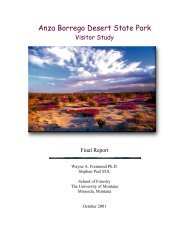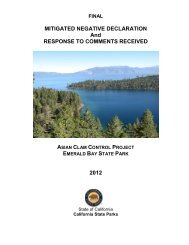Draft EIS/EIR for the San Luis Reservoir SRA Resource ...
Draft EIS/EIR for the San Luis Reservoir SRA Resource ...
Draft EIS/EIR for the San Luis Reservoir SRA Resource ...
Create successful ePaper yourself
Turn your PDF publications into a flip-book with our unique Google optimized e-Paper software.
5. Environmental Analysis<br />
5.5 NEPA/CEQA Environmentally Preferable/Superior<br />
Alternative<br />
The CEQ’s NEPA regulations require that “<strong>the</strong> alternative or alternatives which<br />
were considered to be environmentally preferable” be identified at <strong>the</strong> time an<br />
agency issues its Record of Decision (40 CFR 1505.2). Environmentally<br />
preferable is defined as “<strong>the</strong> alternative that will promote <strong>the</strong> national<br />
environmental policy as expressed in Section 101 of <strong>the</strong> NEPA, meaning <strong>the</strong><br />
alternative that causes <strong>the</strong> least damage to <strong>the</strong> biological and physical<br />
environment. In addition, it also means <strong>the</strong> alternative that best protects,<br />
preserves, and enhances historic, cultural, and natural resources” (CEQ 1981).<br />
The CEQ’s NEPA regulations do not require that <strong>the</strong> alternative be adopted.<br />
Section 101 of <strong>the</strong> NEPA states that:<br />
… it is <strong>the</strong> continuing responsibility of <strong>the</strong> Federal Government to (1) fulfill <strong>the</strong><br />
responsibilities of each generation as trustee of <strong>the</strong> environment <strong>for</strong> succeeding<br />
generations; (2) assure <strong>for</strong> all Americans safe, healthful, productive, and aes<strong>the</strong>tically<br />
and culturally pleasing surroundings; (3) attain <strong>the</strong> widest range of beneficial uses of<br />
<strong>the</strong> environment without degradation, risk to health or safety, or o<strong>the</strong>r undesirable and<br />
unintended consequences; (4) preserve important historic, cultural, and natural aspects<br />
of our national heritage, and maintain, wherever possible, an environment which<br />
supports diversity, and variety of individual choice; (5) achieve a balance between<br />
population and resource use which will permit high standards of living and a wide<br />
sharing of life’s amenities; and (6) enhance <strong>the</strong> quality of renewable resources and<br />
approach <strong>the</strong> maximum attainable recycling of depletable resources.<br />
The CEQA Guidelines (Section 15126.6[a] and [e][2]) require that <strong>the</strong> analysis of<br />
alternatives in an <strong>EIR</strong> include an identification of <strong>the</strong> “environmentally superior<br />
alternative” among all of those considered. In addition, if <strong>the</strong> No Project<br />
Alternative is identified as environmentally superior alternative, <strong>the</strong> <strong>EIR</strong> must<br />
also identify <strong>the</strong> environmentally superior alternative among <strong>the</strong> o<strong>the</strong>r<br />
alternatives. Under CEQA, <strong>the</strong> goal of identifying <strong>the</strong> environmentally superior<br />
alternative is to assist decision-makers in considering project approval. CEQA<br />
does not require an agency to select <strong>the</strong> environmentally superior alternative<br />
(State CEQA Guidelines, Sections 15042-15043).<br />
Alternative 1, <strong>the</strong> No Action/No Project Alternative, would result in <strong>the</strong> least<br />
development but would not implement any of <strong>the</strong> focused management plans<br />
listed in Table 4-1 (boating, vegetation, trails, cultural resources). This alternative<br />
would not result in any new impacts, but existing impacts would continue.<br />
Alternative 2 would have minimal new development. The development under<br />
Alternative 2 would be centered on existing developed areas, and this alternative<br />
would not open new areas up to vehicular access. Alternative 2 also would<br />
include <strong>the</strong> development of focused resource management plans <strong>for</strong> biological<br />
resources and limited analysis of cultural resources. Alternative 3 would have <strong>the</strong><br />
greatest long-range facility development concentrated and clustered in existing<br />
<strong>San</strong> <strong>Luis</strong> <strong>Reservoir</strong> <strong>SRA</strong> 5-71<br />
<strong>Draft</strong> RMP/GP and <strong>Draft</strong> <strong>EIS</strong>/<strong>EIR</strong>
















